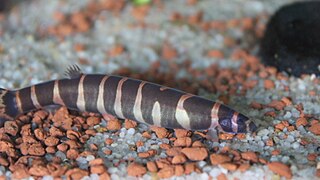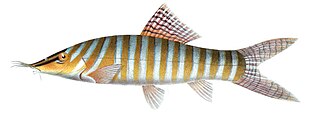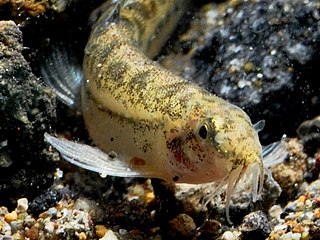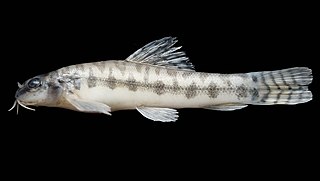
Pangio is a genus of small Asian freshwater fish in the true loach family Cobitidae. In earlier taxonomic schemes it was known as Acanthophthalmus. The "kuhli loach" is well-known in the aquarium trade and commonly identified as P. kuhlii, but most individuals actually appear to be P. semicincta.

Rasbora is a genus of fish in the family Cyprinidae. They are native to freshwater habitats in South and Southeast Asia, as well as southeast China. A single species, R. gerlachi, is only known from an old specimen that reputedly originated from Africa (Cameroon), but this locality is considered doubtful. They are small, up to 17 cm (6.7 in) long, although most species do not surpass 10 cm (4 in) and many have a dark horizontal stripe.

Barbonymus is a ray-finned fish genus in the family Cyprinidae, containing some barb species. The genus was only established in 1999, with the tinfoil barb as type species; thus, these fish are sometimes collectively called tinfoils. The new genus was established in recognition of the fact that some large Asian "barbs", formerly rather indiscriminately lumped in Barbus, Barbodes and Puntius, form a distinct evolutionary lineage.

Mystus is a genus of fish in the family Bagridae native to Asia. Phylogenetic relationships within this genus are poorly understood, though it has been suggested that there are two major lineages.
Acanthocobitis is a genus of freshwater ray-finned fish of the stone loach family, Nemacheilidae. Recent work has suggested that the genus be split into two with the subgenus Paracanthocobitis being raised to a full species, leaving just the type species, Acanthocobitis pavonacea, in the current genus.
Lepidocephalichthys jonklaasi, known as the Jonklaas's loach or the spotted loach, is an endemic fish species restricted to the wet zone of Sri Lanka. The species was first recorded from the Wilpita area. It is currently known from 12 locations in the wet zone including Beraliya, Dombagaskandha, Madakada, Gilimale, Hiyare, Kottawa, Kanneliya, Weddagala, Nakiyadeniya, Pahiyangala and Boralugoda. It is recorded from a wide range of altitudes. Due to its restricted range and the threats to its habitat Lepidocephalichthys jonklaasi, is listed as an Endangered species. The species has already begun to disappear from some of the sites mentioned above due to destruction and fragmentation of its habitat and many other threats that are operating on the species.

Nemacheilus is a genus of stone loaches native to Asia.

Poropuntius is a genus of cyprinid fish found mainly in freshwater habitats of Southeast Asia and Yunnan in China, but P. burtoni is from South Asia. Several species have highly restricted ranges and are threatened, and a single P. speleops is a cavefish.

Schistura is a genus of fish in the stone loach family Nemacheilidae native to the streams and rivers of the southern and eastern Asia. Some of these species are troglobitic.

Betta, is a large genus of small, often colorful, freshwater ray-finned fishes, known as "bettas", in the gourami family (Osphronemidae). The best known Betta species is B. splendens, commonly known as the Siamese fighting fish.

Lepidocephalichthys guntea, the Guntea loach, is a species of cobitid loach native to southern and southeastern Asia. This species reaches a length of 15 centimetres (5.9 in) TL. It uses its intestines to breath, which gives it the ability to adapt to live in a variety of stagnant and flowing environments. This fish is found in the aquarium trade.

The carplets (Amblypharyngodon) are a genus of fishes in the family Cyprinidae. They are up to 20 cm (7.9 in) in total length, and inhabit a wide range of slow-moving or stagnant freshwater habitats in South and Mainland Southeast Asia.
Lepidocephalus is a genus of loaches native to rivers in the Southeast Asian countries of Indonesia, Malaysia and Thailand. Members of this genus are known as "spirit loaches". They resemble the related kuhli loaches and Lepidocephalichthys loaches, but are more robust and generally found deep in large rivers. With little or no light in their habitat, their eyes and pigmentation are reduced to various extent. One species, L. spectrum, completely lacks pigment and eyes, similar to cavefish. They are generally poorly known, but based on the relatively few scientific museum specimens they can reach up to 8 cm (3.1 in) in standard length.

Syncrossus is a genus of six loaches, many of which are popular in the aquarium fish trade. They are primarily found in Southeast Asia, but S. berdmorei also occurs marginally outside this region in far northeastern India. It is one of eight genera in its family.

Crossocheilus, also known as the "algae eaters", is a genus of fish in the family Cyprinidae. It is distributed in China, India, Indonesia, Malaysia and Thailand in Asia. These fish occur in several types of habitat, often fast-flowing rivers with rocky bottoms.

Osteochilus is a genus of cyprinid fishes mainly found in Southeast Asia with a few extending into adjacent parts of China. Additionally, two species are endemic to the Western Ghats in India.

Lepidocephalichthys thermalis, known as the common spiny loach or the spotted loach, is a freshwater fish species found in India and Sri Lanka.

Lepidocephalichthys hasselti is a species of cobitid loach native to southeastern Asia and western Indonesia. This species reaches a length of 45 millimetres (1.8 in) TL.

Paracanthocobitis is a genus, or subgenus, of freshwater fish in the family Nemacheilidae. This genus is known from the Indus basin in Pakistan to the Mekong basin of Cambodia and Laos The type species is Paracanthocobitis zonalternans. Some authorities treat this as a subgenus of Acanthocobitis and Fishbase only includes the five species described in 2015 by Singer & Plant, meaning that P. (A). zonalternans is not the type species.


















